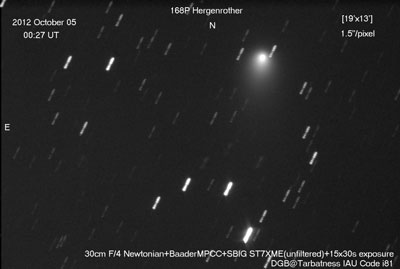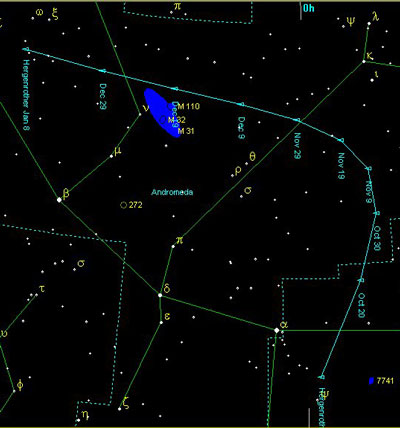
Comet 168P Hergenrother in outburst
BY MARK ARMSTRONG
ASTRONOMY NOW
Posted: 10 October 2012

 Comet 168P/Hergenrother imaged on October 5. Image: Denis Buczynski.
Comet 168P/Hergenrother imaged on October 5. Image: Denis Buczynski.
Where comets are concerned it seems like it never rains but it pours! Comet 168P/Hergenrother was predicted to be just another run-of-the-mill 14th-15th magnitude comet but has undergone an outburst and recent estimates have it at magnitude 9-10, making it currently the brightest comet in the Northern Hemisphere. This news comes hot on the heels of the news that 2012 S1 (ISON) may be an astonishingly bright comet next year, giving us a one-two punch in 2013, with 2011 L4 (PANSTARRS) already predicted to be a naked-eye comet in March.
168P was discovered by Carl Hergenrother at Catalina in 1998 and with a period of 6.9 years, this is its second return. It passed through perihelion (closest point to the Sun on its orbit) on 1 October, triggering the outburst. Recent observations and images show a very strong central condensation within an overall coma of about three arcminutes and a small tail. The comet is currently around 67 million kilometres from Earth (0.450 AU) and 212 million kilometres from the Sun (1.418 AU).
As true astronomical darkness falls arounds 8pm, the comet is already over 40 degrees up, residing within the Great Square of Pegasus, just over three degrees south-west of Alpheratz (alpha Andromeda, mag. +2), the top left hand star of the Square. It transits the southern meridian (culminates) at midnight at a very healthy 65 degrees and in the weeks to come it will move northwards into Andromeda, curving just north of the Andromeda Galaxy (M31)in the week before Christmas.
 Comet 168P/Hergenrother will remain well placed for the rest of the year as it track north out of Pegsus into Andromeda, passing close to M31 just before Christmas. Graphic made using Megastar 5.
Comet 168P/Hergenrother will remain well placed for the rest of the year as it track north out of Pegsus into Andromeda, passing close to M31 just before Christmas. Graphic made using Megastar 5.
At the moment it is an easy object in 20 x 80 binoculars and is yielding good images with DSLR photography. Make the most of any clear slots in the next 10 days or so while the Moon wanes. Please send any sketches and images to Astronomy Now at gallery2012 @ astronomynow.com
|



